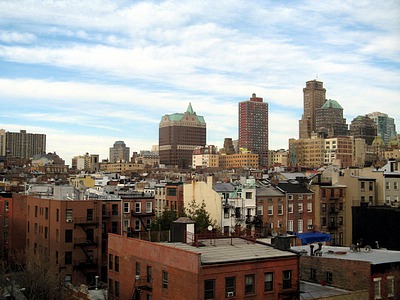 Part of the south side of Brooklyn Heights–the intersection of Hicks and State streets is at the lower left–as seen from the LICH parking garage. In 1956 Robert Moses deemed this area a slum, and wanted to bulldoze it and replace it with high-rise luxury housing ($60 a room!), but, as with his initial plan to build the Brooklyn-Queens Expressway through the Heights, he was thwarted by determined community opposition. (Photo by C. Scales for BHB.)
Part of the south side of Brooklyn Heights–the intersection of Hicks and State streets is at the lower left–as seen from the LICH parking garage. In 1956 Robert Moses deemed this area a slum, and wanted to bulldoze it and replace it with high-rise luxury housing ($60 a room!), but, as with his initial plan to build the Brooklyn-Queens Expressway through the Heights, he was thwarted by determined community opposition. (Photo by C. Scales for BHB.)
The South Heights
Connect with BHB
- curious
- http://selfabsorbedboomer.blogspot.com Claude Scales
- mlo
- Josh G
- Andrew Porter
- Moshe aron Kestenbaum, Williamsburg ODA
- Bob Stone
- http://selfabsorbedboomer.blogspot.com Claude Scales
- Eddy de Lectron
- resident
- nabeguy
- Andrew Porter
- Andrew Porter
- resident
- epc
- Billy Reno
- nabeguy
- EHinBH
- nabeguy
- Jorale-man
- nabeguy
- http://Building Jeffrey J Smith
- http://Building Jeffrey J Smith
- Karl Junkersfeld
- nabeguy
- nabeguy
Nabe Chatter
- RickP on Open Thread Wednesday
- Jorale-man on Carjacking on Joralemon?
- Andrew Porter on Open Thread Wednesday
- Peter Scott-Thomas on Open Thread Wednesday
- Downtown Dad on Open Thread Wednesday
- Arch Stanton on Open Thread Wednesday
- Effective Presenter on Open Thread Wednesday
- Effective Presenter on Open Thread Wednesday
- Bagel Hole on Open Thread Wednesday
- Joshua Olshin on ONE°15 Marina in Chapter 11 Bankruptcy
Latest Stories
Support BHB
Buy essential books about Brooklyn Heights here.
Buy all your favorite AMAZON products via the BHB Store. Click here to get started.
Buy all your favorite AMAZON products via the BHB Store. Click here to get started.
News Tips
If you have a Brooklyn Heights news tip let us know. Click here to send us an e-mail.


